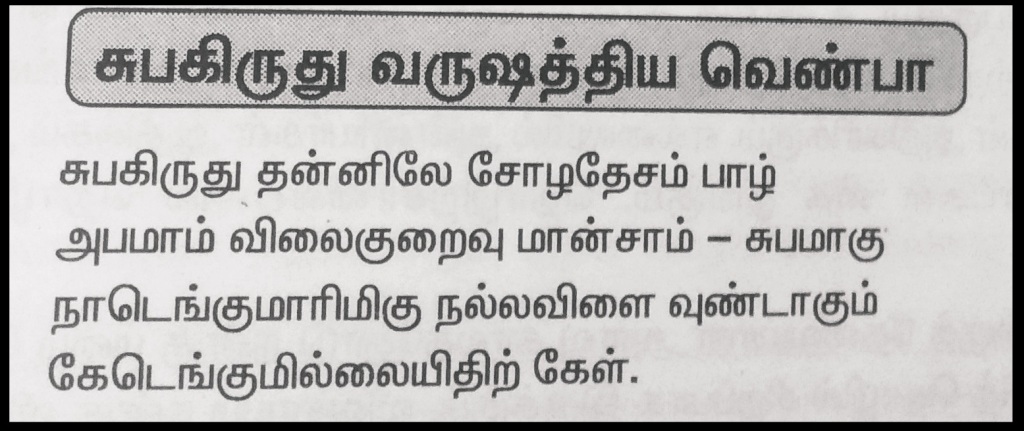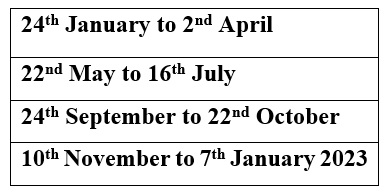This is in continuation of the astrological pointers for Rainfall 2022 posted earlier for the period till 16th July 2022. It can be read HERE
Let me begin this part with the overall prediction model which I outlined last year (HERE).
PANCHANGA – BASED PREDICTION (2022-23 – Śubhakrit year)
- Verse of the year.
The verse states that the Chola country would suffer in this year. There will be a drop in the cost of wood and a hike in the death of deers due to a disease. There will be widespread rain throughout the country ensuring prosperity. Agricultural production will increase.

The Chola country refers to the Kaviri delta region. The suffering could be due to excess rainfall or drought, but the fall in the price of wood and good rainfall for the overall country seem to indicate calamitous rainfall in the cultivable lands of the Chola country including the delta region. This can be further cross checked by planetary yogas.
- Nava – Nayakas
Raja – Saturn (moderate or scanty)
Mantri – Jupiter (plenty of rainfall)
Meghadhipati – Mercury (rainfall by storms, cyclones)
Inference: Overall good rainfall.
- Arudra Pravesha
This took place on 22nd June at 11.42 am.
Lagna – Leo (hot)
Day – Day time (not good)
Moon – Watery sign, Pisces (Good)
Weekday – Wednesday (Mercury’s Day – rainfall by storms)
Inference: Heat induced air circulation leading to rainfall, storms.
- Megha of the Year
Tamo Megha. This ensures good rainfall. The years 1977-78 and 1986-87 had Tamo megha and seen good rainfall attributed to positive IOD.
Overall inference from the Panchanga features: Good rainfall.
PLANET-BASED PREDICTION
- Mercury-Venus closeness
The table shows the closeness period of Mercury and Venus, the most essential factor for rainfall in the country.

It shows a lull between 16th July and 24th September. It also shows that NEM will be very good. In the lull period we have to look for other planetary yogas for rainfall.
- Saturn – Mars – Sun in alternate signs.
This is an important feature that had produced excess rainfall leading to floods. This year this combination occurs four times.
(a) Between 26th June and 12th July:
Saturn in Aquarius, Mars in Aries and Sun in Gemini.
The cloudburst at Amarnath occurred in this period on 9th July when Moon was crossing Ketu in the sign opposite to Mars and Rahu. Mars, the fiery planet lent the heat needed for triggering the cloudburst.
Whenever Ketu and Rahu are crossed by planets like Moon, Venus and Mercury, rainfall increases.
Sun in the lead of all the planets in Gemini ensures very good rainfall in the western regions of India (Gemini = West)
(b) Between 11th August and 17th August:
Saturn in Capricorn, Mars in Taurus and Sun in Cancer.
Sun is joined with Venus in Cancer, a watery sign. This gives very good rainfall to North and North west of India.
There is a spoiler however with Saturn in direct opposition to the Sun. With both supportive and spoiling features, the rainfall will not be excess. No floods expected from the rainfall of this period.
(c) Between 18th September and 16th October:
Saturn in Capricorn, Mars in Taurus and Sun in Virgo.
Mercury-Venus closeness occurs in this period, adding to the rainfall potential. The closeness begins on 24th September when a meteorological event might occur.
Jupiter is in retrogression in a watery sign (Pisces). However mutual opposition of the Sun and Jupiter is not good. So that will moderate the effect.
Venus in favorable stars in the east offsetting any spoiling effect of Jupiter-opposition.
Mercury will be in retrogression in this period ensuring good rainfall.
The location of the sun and Mercury in Virgo points to South as the beneficiary.
The verse of the year on Chola country might be valid for this period when stormy weather is likely to prevail in South India and South Tamilnadu in particular.
(d) Between 17th November and 15th December
With the entry of the Sun in Scorpio (watery sign) on 17th November, the three planets Sun, Mars and Saturn would start transiting in alternating signs.
The close proximity of the sun with Mercury and Venus while Venus is in the lead, ensures excess rainfall.
On 21st November Moon enters Libra when Venus and Mercury move into deep conjunction indicting excess rainfall or a meteorological event.
On the midnight of 22nd November, moon crosses Ketu while Mercury and Venus continue in deep conjunction.
Jupiter comes out of retrogression on 23rd November. South west of Peninsular India will face flood-like situation.
- Rainfall continues till 24th November when Mercury crosses Venus to come in the lead.
- Venus in favorable stars.
Venus appearing in eastern sky (before sun rise) transiting the stars Magha, Purva Phalguni, Uttara Phalguni, Hasta and Chitra and in the western sky (after sunset) transiting the stars Swati, Vishakha and Anusha brings copious rains throughout the transit period.
- This year it begins the good transit in the eastern sky in Magha right from 1st September
On 18th October starts crossing the sun indicating very heavy rainfall caused by a meteorological event. On that date Mars and Sun will be in zero degrees indicating stormy, heat triggered event of rainfall.
From 18th to 22nd October, Venus will continue to be behind the sun within one degree indicating a sustained rainfall on all these dates.
On 23rd, 24th and 25th both Venus will be in deep conjunction with the Sun on the same degree. Only on 26th October it crosses the sun and goes ahead by a degree.
In this period there is Amavasya and Solar eclipse on 24th October / 25th October, 24th being Deepavali day. There is going to be a wet Deepavali.
From 18th to 24/ 25th October, some meteorological event will take place ensuring good rainfall. The location is South India, and west of Peninsular India.
After crossing the Sun, Venus comes in the lead of all the planets ensuring continued rainfall. By then Venus also moves to the west of the Sun and starts transit in favorable stars starting from Swati.
- The next favorable transit of Venus comes up immediately after that on 2nd November when it crosses Ketu. That will also be a date of good trigger to rainfall. Following Venus, the other planets also cross Ketu one by one ensuring rainfall.
Eventful November:
- On 2nd November, Venus crosses Ketu (good rainfall)
- On 5th November, the Sun crosses Ketu (good rainfall)
- On 6th November, Mercury crosses Ketu (good rainfall)
- On 7th, 8th and 9th November, Mercury crosses the Sun (good rainfall)
- On 10th November, Mercury- Venus closeness begins (Rainfall period)
- On 11th November, Sun and Saturn will be exactly 90 degrees apart while Venus enters the next sign which happens to be watery Scorpio (meteorological trigger / good rainfall)
- On 13th November, Mercury crosses over to the next sign (watery sign) to join Venus. Spurt in rainfall in western parts of Peninsular India.
- On 17th November, the sun enters the next sign (watery) to join with Mercury and Venus.
- From 17th to 23rd November, Mercury will be within one degree of Venus, indicating a prolonged meteorological event coupled with heavy rainfall.
- On 23rd November, Jupiter comes out of retrogression indicating heavy rainfall.
- On 24th November, Mercury crosses Venus and takes the lead. With that a major stormy meteorological event gets over. When Mercury crosses Venus, dry winds begin.
- Starting from 17th November Saturn, Mars and Sun will be in alternating signs ensuring good rainfall.
- Till 3rd December the rainfall spree continues with Moon joining Jupiter in watery Pisces on 2nd and 3rd December. On 3rd December, Mercury moves to the next sign, Sagittarius.
- On 5th December, Venus moves to Sagittarius to join with Mercury. The closeness continues indicating rainfall.
- On 29th December, Mercury begins retrogression indicating rainfall towards the end of December and the first week of January 2023. This means Solar / Margazhi Garbottam for 2023 will be WASHED OUT.
By then Mars is going to be in the lead of all the planets which will continue till 20th September 2023.
A very hot summer 2023 and drought conditions throughout India for most of SWM 2023 is indicated by this. For the current year (2022) we can stay assured that there will be no water crisis throughout India but only troubles from floods. Aippasi and Karthigai months would be wet throughout.
UPDATE
On 23rd November Jupiter came out of retrogression. Going by our past records, this must have caused a cyclone. It did generate a Depression which was formed on 20th November. It ‘however struggled to consolidate a well-defined center. It made landfall after degenerating into a remnant low-pressure area. It caused minor impacts to Andhra Pradesh, Tamil Nadu, and Karnataka.’ (https://en.wikipedia.org/wiki/2022_North_Indian_Ocean_cyclone_season ) The landfall was on 23rd November.
The probable cause for the low key or less impact is that Jupiter was a benefic. It is not supposed to cause heavy damage. Though the entire season of 2022 had seen rains right from the time Jupiter started retrogression, it didn’t cause havoc while coming out of retrogression. In contrast Cyclone Asani evolved into a tropical storm on 10th May, 2022 when Mercury started retrogression. Cyclone Sitrang which formed on 17th October made a landfall on 23rd October when Saturn ended retrogression. Associated with Saturn, a malefic, this cyclone was fierce and did create havoc.
The next one was the severe cyclone, Mandous which had its genesis on 6th December. There was no trigger factor by way of retrogression or combustion, but we already predicted that this period will see floods due to Sun- Mars- Saturn coming in alternate signs. Moreover Venus and Mercury were in close degrees to each other. At the time of landfall on 9th December (11-30 pm to 1 am) near Mamallapuram, Mercury and Moon were in exact coupling at 180 degrees from each other with Venus within 5 degrees behind Mercury.
On 15th and 16th December, the Sun is moving into Sagittarius to join with Mercury and Venus. This will once again trigger fresh rainfall. With the solar garbottam of Chennai ( https://jayasreeweatherblog.wordpress.com/2022/01/20/solar-margazhi-garbottam-prediction-for-chennai-rainfall-2022/) showing rainfall on 19th and 20th, the expected meteorological activity is likely to bring rainfall to Chennai.
Looks intresting.Yu have mentioned the date november 11th yesterday there was a record rainfall in delta regions.Yu wud have known
Mercury has just transited from thulam to vrichikam yesterday evening/Night.Venus mercury and sun (Combustion) are very closer with a malefic planet ketu
LikeLike